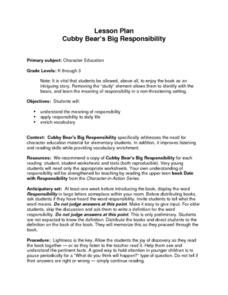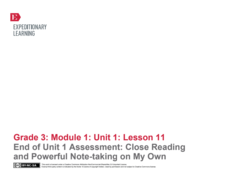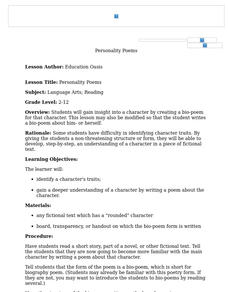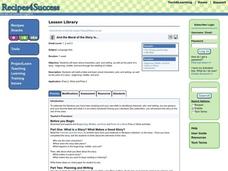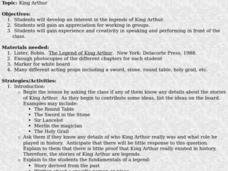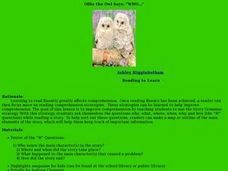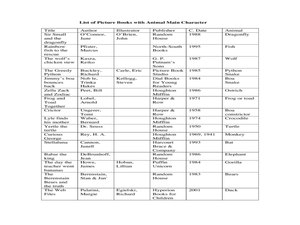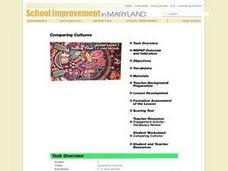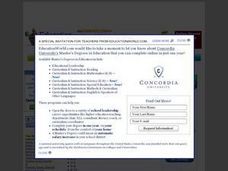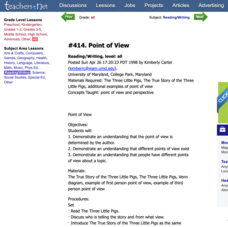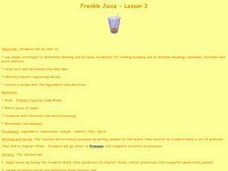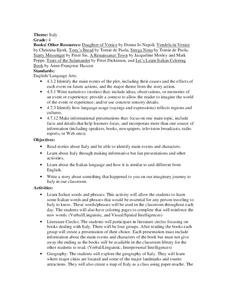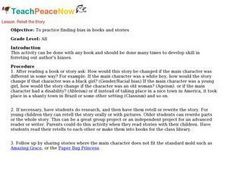Curated OER
Cubby Bear's Big Responsibility
Pupils continue their examination of character by being introduced to the concept of responsibility. As a class, they are read a story and identify when the main character was being responsible. They share wha they are responsible for...
EngageNY
Close Reading of That Book Woman: How Did People Access Books in Rural Areas of the United States?
For this ninth lesson plan in a larger beginning-of-the-year unit, close reading skills are used independently to find the gist of the story That Book Woman. Rereading for important details is the targeted skill to unlock a deeper...
Hawaiʻi State Department of Education
Cinderella
Reading fairy tales is so much fun! Learners use dramatic play to assist them in defining and expressing the main theme found in the story of Cinderella. Each group is given a story card and will create a tableau based on the main point...
EngageNY
End of Unit 1 Assessment: Close Reading and Powerful Note-Taking on My Own
As the final lesson plan in a larger beginning-of-the-year unit to establish routines and teach close reading skills, this plan is designed as an assessment piece. Using the story, The Librarian of Basra, learners independently...
Curated OER
Author's Purpose Lesson Plans
Why do we practice identifying the author's purpose? Read this article to gain a better understanding of this reading strategy, and then peruse the attached lesson plans!
Curated OER
Personality Poems
Students create a bio-poem for themselves or characters in stories they have read. They explore common character traits.
Curated OER
And the Moral of the Story is...
Learners discover the parts of a story through the retelling of a fable as well as characters, plot, and setting. This activity is completed using the program Pixie to create an online storybook.
Curated OER
My Book Report
In this literacy/writing worksheet, learners compose a book report. Students identify the following literary elements: main characters, setting, beginning, problem and solution. Learners then compose paragraphs for each of these story...
Curated OER
King Arthur
Young scholars explore literary classics by reading The Legend of King Arthur. In this legendary story lesson, students read the story The Legend of King Arthur and identify the main characters and how they will reenact the story. Young...
Curated OER
Ollie the Own Says: WHO
Scholars examine the strategy of making a story map or outline to identify the main elements of a story. They discuss the who, what, where, when, why, and how of a story, in an outline form. As a class they read a short story, answer the...
Curated OER
Find an Animal! Find a Book!
Students identify the themes of different books by classifying their genre. In this genre lesson plan, students examine a specific animal by reading both a nonfiction and fiction book about the species. Students compare the...
Curated OER
Comparing Cultures
Young readers compare two stories/cultures, identifying how they are alike and different. They share their own version of a well-known story and adapt it to another culture. They explain their adaptations.
Curated OER
Character and their Significance
Students read short stories and write a response to the story about the character and their significance. In this character lesson plan, students also create a poster to represent their character.
Curated OER
Character and Plot Development Through Comics
Third graders are introduced to character, plot development, point of view, and tone through the use of comic strips. They, in pairs, identify these four attributes in the comic strip and present their findings to the class.
Curated OER
Pandora Puppy's Caring Circle
Students are introduced to the concept of compassion. As a class, they read a story together about Pandora Puppy's caring circles and identify the main points. They complete a worksheet and take a test to review how compassion is...
Curated OER
Celebrate Character Counts Week
Students participate in activities to celebrate character counts week. They identify the six pillars of character. They display good character when it comes to everyday tasks.
Curated OER
Story Structure Slide Show
Analyzing the sequence of actions in dramatic stories leads to deeper comprehension of story structure. The class identifies the main actions in each section of a story and develops frozen tableau's for the identified actions of the...
Teachers.net
Point of View
Work with your class on point of view by reading "The Three Little Pigs." Learners demonstrate an understanding that the point of view is determined by the author and that different points of view exist. They then read a different short...
Curated OER
Reviewing Main Events in Fiction
Young scholars analyze elements of fiction while reading. In this reading analysis lesson, students read specific texts and retell the information they remember. Young scholars discover how sequential storytelling works.
Curated OER
Freckle Juice - Lesson 3
Students complete activities with the book Freckle Juice by Judy Blume. In this literature instructional activity, students read Chapter two and find the definitions for new vocabulary words. They also complete an online activity...
Curated OER
Plot and Conflict List
In this language arts worksheet, students use this check sheet and list to help identify the main problem, character's goal and resolution in a story.
Curated OER
Italy
Learners read stories about Italy and identify main events and characters. They take an imaginary trip to Italy and write a story about their adventures. In addition, they practice several italian words and phrases.
Curated OER
Retell the Story
Students identify bias in books. In this character education lesson, students read a text and discuss any gender or racial bias which may be present. Students retell and rewrite the story in a fair way.
Curated OER
Character Scrapbook Teacher's Guide
Students analyze a book's characters and create a scrapbook to print and save. In this on line interactive characterization lesson plan, students identify character traits and gain a deeper understanding of a book's characters.
